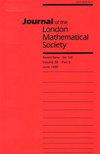加热铁流体流动模型的时周期解法
IF 1
2区 数学
Q1 MATHEMATICS
Journal of the London Mathematical Society-Second Series
Pub Date : 2024-09-18
DOI:10.1112/jlms.12990
引用次数: 0
摘要
在这项研究中,我们证明了一个描述从下部加热的铁流体流动模型的时间周期解的存在性。流体速度满足的纳维-斯托克斯方程与温度方程和磁势满足的磁静力方程耦合。磁化假定与磁场平行,并由概括了朗格文定律的非线性磁化定律给出。证明基于半加尔金近似和正则化方法以及定点法。本文章由计算机程序翻译,如有差异,请以英文原文为准。
Time-periodic solutions to heated ferrofluid flow models
In this work, we prove the existence of time-periodic solutions to a model describing a ferrofluid flow heated from below. Navier–Stokes equations satisfied by the fluid velocity are coupled to the temperature equation and the magnetostatic equation satisfied by the magnetic potential. The magnetization is assumed to be parallel to the magnetic field and is given by a nonlinear magnetization law generalizing the Langevin law. The proof is based on a semi-Galerkin approximation and regularization methods together with the fixed point method.
求助全文
通过发布文献求助,成功后即可免费获取论文全文。
去求助
来源期刊
CiteScore
1.90
自引率
0.00%
发文量
186
审稿时长
6-12 weeks
期刊介绍:
The Journal of the London Mathematical Society has been publishing leading research in a broad range of mathematical subject areas since 1926. The Journal welcomes papers on subjects of general interest that represent a significant advance in mathematical knowledge, as well as submissions that are deemed to stimulate new interest and research activity.

 求助内容:
求助内容: 应助结果提醒方式:
应助结果提醒方式:


